Advertisements
Advertisements
Question
If an object is placed in front of a convex lens beyond 2F1, then what will be the position, relative size, and nature of an image which is formed? Explain with a ray diagram.
Solution
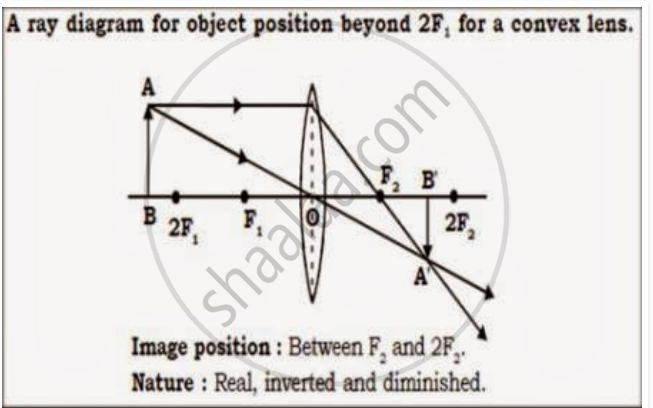
APPEARS IN
RELATED QUESTIONS
"A convex lens can form a magnified erect as well as magnified inverted image of an object placed in front of it." Draw ray diagram to justify this statement stating the position of the object with respect to the lens in each case.
Which of the following lenses would you prefer to use while reading small letters found in a dictionary?
An object 5 cm in length is held 25 cm away from a converging lens of focal length 10 cm. Draw the ray diagram and find the position, size and the nature of the image formed.
An object is placed at a distance of 15 cm from a concave lens of focal length 30 cm. List four characteristics (nature, position, etc.) of the image formed by the lens.
Write one condition where it does not bend when entering a medium of different optical density.
An object of height 4.0 cm is placed at a distance of 30 cm from the optical centre 'O' of a convex lens of focal length 20 cm. Draw a ray diagram to find the position and size of the image formed. Mark optical centre 'O' and principal focus 'F' on the diagram. Also find the approximate ratio of size of the image to the size of the object.
An object is placed at a distance of 12 cm from a convex lens of focal length 8 cm. Find :
1) the position of the image
2) nature of the image
A beam of light travelling in a rectangular glass slab emerges into air. Draw a ray-diagram indicating the change in its path.
A beam of light travelling in air is incident of water. Draw a ray-diagram indicating the change in its path in water.
Where should an object be placed in front of a convex lens so as to obtain its real, inverted and magnified image?
If an object is at a considerable distance (or infinity) in front of a convex lens, where is the image formed?
Fill in the following blank with suitable word:
Parallel rays of light are refracted by a convex lens to a point called the ........
Fill in the following blank with suitable word:
The image in a convex lens depends upon the distance of the ........... from the lens.
What is a lens?
Distinguish between a convex lens and concave lens. Which of the two is a converging lens : convex lens of concave lens?
Describe with the help of a ray diagram the nature, size and position of the image formed when an object is placed in front of a convex lens between focus and optical centre. State three characteristics of the image formed.
How could you find the focal length of a convex lens rapidly but approximately?
A convex lens of focal length 6 cm is held 4 cm from a newspaper which has print 0.5 cm high. By calculation, determine the size and nature of the image produced.
Which type of lenses are:
thicker in the middle than at the edges?
A beam of parallel light rays is incident through the holes on one side of a box and emerges out through the holes on its opposite side as shown in the diagram below:
Which of the following could be inside the box?
(a) a rectangular glass block
(b) a concave lens
(c) a convex lens
(d) a glass prism
An image formed on a screen is three times the size of the object. The object and screen are 80 cm apart when the image is sharply focussed.
State which type of lens is used.
The diagram alongside shows the refraction of a ray of light from sir to a liquid.
(a) write the values of (i) angle of incidence, (ii) angle of refraction.
(b) use snell’s law to find the refractive index of liquid with respect to air.
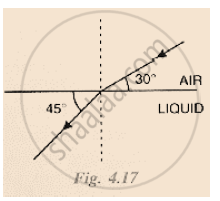
A parallel oblique beam of light falls on a convex lens. Draw a diagram to show the refraction of light through the lens.
Study the diagram below.
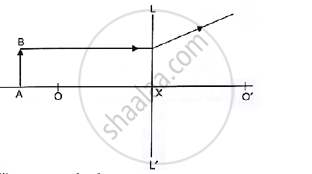
what are the points O, O’ called?
The given below figure shows an object OA and its image IB formed by a lens. State three characteristics of the image.
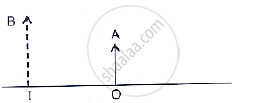
In the following cases, where must an object be placed in front of a convex lens so that the image formed is inverted and enlarged?
In the following cases, where must an object be placed in front of a convex lens so that the image formed is upright and enlarged?
A teacher sets up the stand carrying a convex lens of focal length 15 cm at 42.7 cm mark on the optical bench. He asks four students A, B, C and D to suggest the position of screen on the optical bench so that a distinct image of a distant tree is obtained almost immediately on it. The positions suggested by the students were as
A. 12.7 cm
B. 29.7 cm
C. 57.7 cm
D. 72.7 cm
The correct position of the screen was suggested by
(a) A
(b) B
(c) C
(d) D
While determining the focal length of a convex lens, you try to focus the image of a distant object formed by the lens on the screen. The image formed on the screen, as compared to the object, should be
(A) erect and highly diminished
(B) erect and enlarged
(C) inverted and enlarged
(D) inverted and highly diminished
If you are to determine to focal length of a convex lens, you should have
(A) a convex lens and a screen
(B) a convex lens and a lens holder
(C) a lens holder, a screen holder and a scale
(D) a convex lens, a screen, holder for them and a scale
Observe the following figure and answer the questions.
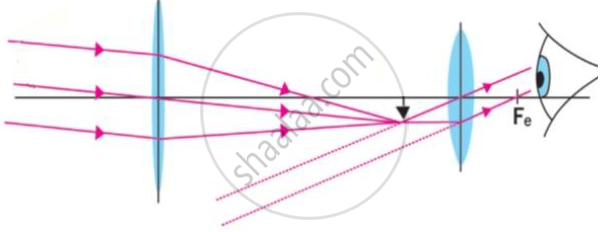
a) Which optical instrument shows arrangement of lenses as shown in the figure?
b) Write in brief the working of this optical instrument.
c) How can we get different magnifications in this optical instrument?
d) Draw the figure again and labelled it properly
State the position of object, position of image, nature of image when: Convex lens is used in cine projector.
State the nature and position of the object on the principal axis to obtain a virtual and magnified image.
Write the three characteristics of the image formed by a convex lens of focal length 20 cm for the object at distance (i) 10 cm, (ii) 30 cm, (iii) 40 cm, (iv) 60 cm from the lens.
An object is placed in front of a convex lens such that the image formed has the same size as that of the object. Draw a ray diagram to illustrate this.
Find the odd one out and give its explanation.
A beam of light is incident through the holes on side A and emerges out of the holes on the other face of the box as show in the figure. Which of the following could be inside the box?
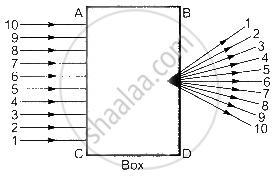
Distinguish between:
Concave lens and Convex Lens
